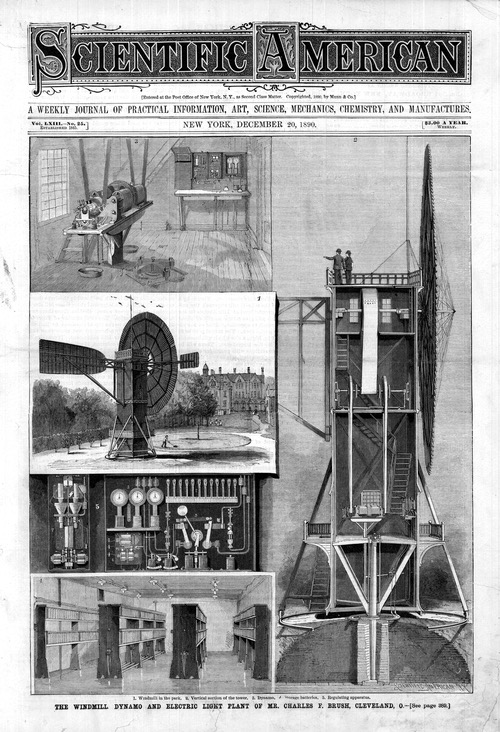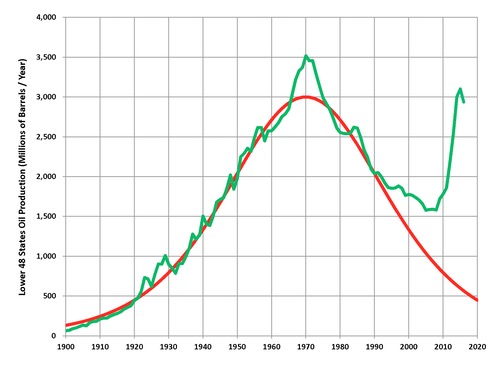It is difficult to estimate the effect of an invention on existing practices and industries. Occasionally a new invention will appear which will greatly affect a whole range of allied inventions and industries in such a way as to entirely change time-honored customs, inaugurate new practices and establish new arts…
– from ‘Mr. Brush’s Windmill’, an article about the first wind turbine in Scientific American, published in December 1890

America has been going through an extended period of confusion about energy since around 1890 — the year Charles F. Brush of Cleveland, Ohio built his amazing windmill dynamo. Mr. Brush had made a fortune as an inventor, and was able to retire comfortably at age 40. Like many retirees, he needed to find things to keep himself occupied. He probably could have taken up golf, except that Cleveland didn’t get its first golf course until 1895. So instead, Mr. Brush decided to build an 85-foot tall windmill in his backyard, to power an electricity-generating turbine.
From a 2011 article by Luke Hagedorn, published on the Renewable Energy Law Insider website:
The structure itself was a technical marvel, and represented the first fully-automated electricity generating wind turbine in the world. Standing just over 85 feet tall, the turbine featured a 56-foot wide wheel that was made up of 144 blades with a surface area of 1,800 square feet. Additionally, the entire structure was on a revolving platform and utilized a 60-foot long tail which turned the wheel directly into the wind…
…Mr. Brush even thought to tackle one of the biggest problems that still plagues the wind industry, battery storage. In the basement of Mr. Brush’s mansion was a series of 408 battery cells, each with a capacity of 100 ampere hours. This allowed Mr. Brush to have a continuous supply of electricity, even when the wind was not blowing…
For the next 20 years, Mr. Brush’s windmill powered 350 incandescent lights in his handsome home — at which point, I presume, industrialized electricity had become available in the Cleveland area, and the windmill ceased to be cost-effective. Nevertheless…
…In the end, Mr. Brush’s amazing wind dynamo stands as a truly amazing display of ingenuity and the motivational power of too much free-time.
Windmills have been around for 1500 years; the Persians began using wind power to grind grain in about 500 AD. But Charles Brush may have been the first person to use a windmill to generate electricity. Which brings us to an interesting aspect to the somewhat confusing story of modern energy utilization. Mankind has developed various energy technologies through history, and the technologies fall into roughly two categories.
- Energy resources. These are forms of energy such as coal, oil, wind, sunlight, that deliver more energy than is required to extract that energy. Net positive energy sources.
- Energy carriers. These are forms of energy that require more energy to produce than they deliver to the end user. Electricity typically fits into this category. Net negative energy sources.
I was introduced to this idea in a 50-page paper entitled “Energy Transitions” written in 2010 by Peter O’Connor, who was at the time a doctoral candidate in the Geography and Environment Department at Boston University. (You can download his fascinating paper here.) Mr. O’Connor briefly described these two different types of energy in his definition of “Energy Return on Investment.”
Electricity exists everywhere in nature, in the form of static electricity… lightning being its most dramatic form. But the AC and DC electricity we use to light our homes, and run our computers and air conditioners — and, increasingly, our electric vehicles (EVs) — is a man-made product, and it always takes more energy to produce and transmit the electricity than we get at the other end of the wire. In 1890, Mr. Brush was using a natural and freely-available energy source — the wind — to generate the electricity for his home, but here in Colorado we’ve been getting our electricity mainly from coal-fired generators.
You cannot drill into the ground and find ‘electricity’… the way you can drill a well, and find oil or natural gas. But at the same time, we have a theoretically unlimited supply of electricity. Oil and natural oil, sucked out of the ground, is a limited resource, and it gets more and more expensive to extract as supplies become depleted. The world’s supply of electricity is not, as far as we can tell, subject to depletion. And electricity travels from place to place without generating pollution. (If you don’t include electromagnetic radiation, which we’ve touched on in the past, and which will be the subject of future editorials, no doubt.) Not so with oil and gas. Their supply is limited… and they cause pollution… possibly even “climate change.”
In 1956, geologist M. King Hubbert presented a formal theory about “peak oil”. The term is used in different ways, but I am using it in a particular sense. Petroleum was relatively easy to locate and extract between 1865 — when John D. Rockefeller created the Standard Oil Company — and 2006, which marked, according to the International Energy Agency, the peak of conventional oil extraction and production. But the challenge of locating new oil fields and the ever-more-challenging extraction situations (in, for example, the frozen wastes of Prudhoe Bay in Alaska) promised that oil was destined to become more and more expensive. Were it not for the invention of hydraulic fracturing (“fracking”) and horizontal drilling, Hubbert’s predictions about peak oil production in the US — which he calculated would take place around 1970 — would have proved pretty accurate.

US average annual production peaked in 1970 at 9.6 million barrels per day and mostly declined for more than three decades thereafter. However, the use of hydraulic fracturing and horizontal drilling caused US production to rebound starting in about 2005.
Hubbert’s original predictions for world-wide peak oil production also proved premature. Nevertheless, the rate of discovery of new petroleum deposits peaked worldwide during the 1960s and has never approached these levels since.
From O’Connor’s paper on energy transitions:
The United States developed its patterns of energy use based on abundant low-cost energy sources. English settlers found firewood in an abundance unknown in their home country, and used it for domestic heating, iron smelting, and early steam engines. The country turned out to be enormously wealthy in coal, oil, natural gas, and hydropower.
Decisions based on this abundance — sprawling suburbs, limited public transportation, and huge, artificially-lit, air-conditioned buildings — created an economy that uses more energy per capita than any other developed country, as well as more energy per unit of gross domestic product (GDP).

Is electricity our new destiny?
